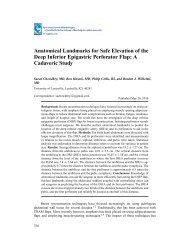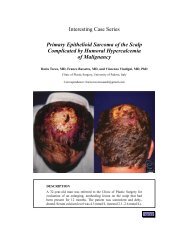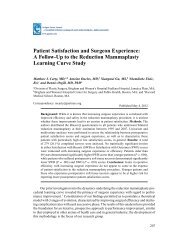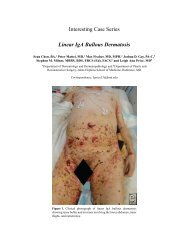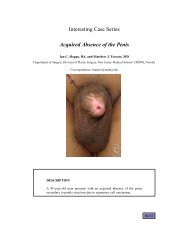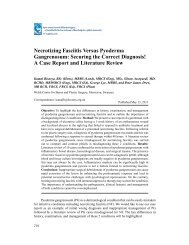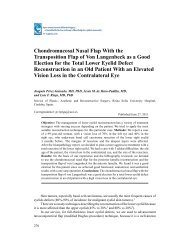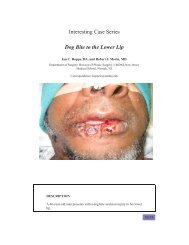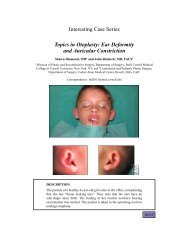Penetrating Injury to the Upper Extremity - ePlasty
Penetrating Injury to the Upper Extremity - ePlasty
Penetrating Injury to the Upper Extremity - ePlasty
You also want an ePaper? Increase the reach of your titles
YUMPU automatically turns print PDFs into web optimized ePapers that Google loves.
Interesting Case Series<br />
<strong>Penetrating</strong> <strong>Injury</strong> <strong>to</strong> <strong>the</strong> <strong>Upper</strong> <strong>Extremity</strong><br />
Ruth N. Celestin, MD, and Ramazi Datiashvili, MD<br />
New Jersey Medical School, Division of Plastic Surgery, University of Medicine and Dentistry, NJ<br />
Correspondence: diatiasro@umdnj.edu<br />
DESCRIPTION<br />
A 16-year-old right-hand-dominant adolescent boy presents <strong>to</strong> <strong>the</strong> emergency department<br />
with multiple lacerations <strong>to</strong> <strong>the</strong> right forearm after falling through a glass table with<br />
an outstretched hand. He has pulsatile bleeding from <strong>the</strong> proximal wound and normal<br />
sensorimo<strong>to</strong>r examination of <strong>the</strong> right hand.
QUESTIONS<br />
1. What structures are most likely injured in this patient<br />
2. List 4 signs of arterial injury in an upper extremity.<br />
3. What type of surgical treatment is indicated
DISCUSSION<br />
The presence of brisk bleeding from <strong>the</strong> upper extremity laceration in this patient coupled<br />
with a normal sensorimo<strong>to</strong>r examination of <strong>the</strong> right hand indicates a high likelihood of<br />
isolated arterial injury. Physical examination should include palpation for pulses; however<br />
<strong>the</strong> presence of a radial pulse in <strong>the</strong> upper extremity does not rule out proximal injury <strong>to</strong><br />
<strong>the</strong> vessel. This is because of <strong>the</strong> rich collateralization of blood flow around <strong>the</strong> shoulder<br />
and elbow. Conventional angiography may be of use in evaluating patients where <strong>the</strong> level<br />
of injury is unclear, but it is rarely needed.<br />
Reliable indica<strong>to</strong>rs of extremity arterial injury include active or pulsatile hemorrhage,<br />
pulsatile or expanding hema<strong>to</strong>ma, diminished or absent pulses, and evidence of ischemia<br />
on clinical examination.<br />
Conservative nonsurgical treatment of <strong>the</strong>se injuries remains controversial. In surgical<br />
treatment, incisions in <strong>the</strong> extremities are designed longitudinally over <strong>the</strong> injured vessel<br />
and are extended proximally and distally as necessary.<br />
While some studies demonstrate <strong>the</strong> development of claudication, extremity weakness,<br />
and cold in<strong>to</strong>lerance, overall review of <strong>the</strong> literature would suggest that ligation of an isolated<br />
radial or ulnar artery is appropriate and well <strong>to</strong>lerated. When both <strong>the</strong> arteries are injured,<br />
<strong>the</strong> repair of ulnar artery takes precedence because of its role as <strong>the</strong> dominant arterial supply<br />
<strong>to</strong> <strong>the</strong> hand.<br />
The type of vascular repair depends on <strong>the</strong> nature of <strong>the</strong> arterial damage. Sharp injury<br />
often lends itself <strong>to</strong> primary repair. Primary repair with an end-<strong>to</strong>-end anas<strong>to</strong>mosis is<br />
performed with a running or interrupted nonabsorbable monofilament suture. If a large gap<br />
prevents tension-free repair, reversed saphenous or cephalic-vein au<strong>to</strong>genous interposition<br />
grafts must be used for reconstruction.<br />
All repairs must be covered with viable soft tissue. Splinting of <strong>the</strong> extremity is<br />
useful for preventing disruption of <strong>the</strong> repair with patient movement. It is also important<br />
<strong>to</strong> avoid compression of <strong>the</strong> vascular repair. Intraoperative completion arteriography is<br />
recommended, and palpable distal pulses should be documented after repair. Venous injury<br />
<strong>to</strong> <strong>the</strong> upper extremity rarely requires repair because <strong>the</strong> collateral network is extensive.<br />
Ligation of <strong>the</strong> venous injury is typically well <strong>to</strong>lerated.
REFERENCES<br />
1. Feliciano DV, Mat<strong>to</strong>x KL, Graham J, et al. Five-year experience with PTFE grafts in vascular wounds.<br />
J Trauma. 1985;25:71-9.<br />
2. Prichayudh S, Verananvattna A, Sriussadaporn S, et al. Management of upper extremity vascular injury:<br />
outcome related <strong>to</strong> <strong>the</strong> Mangled <strong>Extremity</strong> Severity Score. World J Surg. 2009;33(4):857-63.<br />
3. Johansen K, Lynch K, Paun M, Copass M. Non-invasive vascular tests reliably exclude occult arterial<br />
trauma in injured extremities. J Trauma. 1991;31(4):515-9; discussion 519-22.<br />
4. Rothkopf DM, Chu B, Gonzalez F, Borah G, Ashmead D IV, Dunn R. Radial and ulnar artery repairs:<br />
assessing patency rates with color Doppler ultrasonographic imaging. J Hand Surg. 1993;18:626-8.<br />
5. Johnson M, Ford M, Johansen K. Radial or ulnar artery laceration. Repair or ligate Arch Surg.<br />
1993;128(9):971-4; discussion 974-5.<br />
6. Raskin KB. Acute vascular injuries of <strong>the</strong> upper extremity. Hand Clin. Feb 1993;9(1):115-30.<br />
Celestin and Datiashvili. <strong>Penetrating</strong> <strong>Injury</strong> <strong>to</strong> <strong>the</strong> <strong>Upper</strong> <strong>Extremity</strong>. www.<strong>ePlasty</strong>.com, Interesting Case,<br />
January 21, 2013




